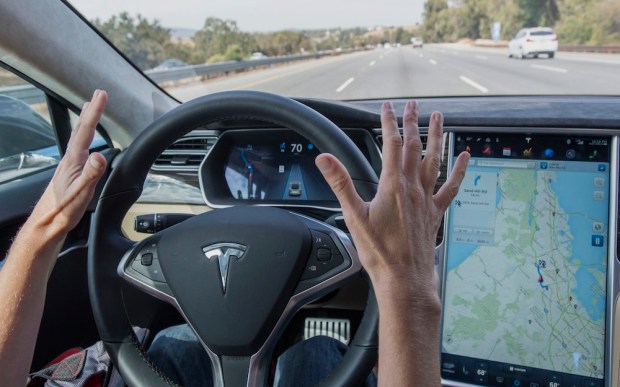Is Tesla’s Master Plan Out Ubering Uber?

Tesla speculation is a favored pastime in Silicon Valley and beyond for reasons pretty obvious. The product is cool, the technology is innovative and the founder is a prolific entrepreneur. Media likes to talk about Tesla because Tesla is fun to talk about.
But this week Tesla has bounced into the news for rather unexpected reasons – emerging reports from some rather respected Wall Street guru types that indicate that the next move for Tesla may well be to attempt to out Uber Uber – with a fleet of self-driving vehicles programed for the job.
On the one had this is both not at all surprising, and extremely surprising.
The not-so-surprising part comes from the simple fact that CEO Elon Musk has been whistling a jaunty – or by some accounts completely nutty – tune about Tesla’s rapidly forthcoming self-driving future. “Auto-pilot” was announced by Tesla last fall – and though its not quite a self-driving car and Tesla urges consumers to keep their hand on the wheel – will manage a drivers speed and keep them in their lane when engaged. And that according to Musk is just the beginning – he foresees fully autonomous self driving car being road ready (by a design standard, not a regulatory one) within the next three years.
The surprising part is that recent events don’t seem to have dimmed that enthusiasm for the autonomous auto-future. Tesla’s autopilot system has been the subject of a federal investigation since an early May fatal auto crash involving a Tesla Model S. The National Highway Traffic Safety Administration has released a detailed set of questions for the carmaker about its automated driving system – particularly in regards to its emergency braking function.
Tesla has been criticized for rolling out partial self driving features in “beta” mode and some engineers have objected conceptually to automated automated systems that rely on the driver’s ability to suddenly operate the vehicle. But Tesla has stood by its product – noting that the autodriving systems performed perfectly in extremely rigorous testing – and that user error is always a risk in a car, whether or not there is auto-pilot technology to augment there efforts. Tesla has also said it has not intention of rolling back the 70,000 or cars that already are up and running with the beta test.
And that, notes David Teater, a prominent traffic safety advocate, is a mistake.
“Would you want your kid jumping into a Tesla and turning on driving assist after what’s just happened?” Mr. Teater asked. “Right now the technology is more about marketing than safety.”
That Tesla would disagree with that is certain – but as of this week it seems that Teeter might also get some pushback from various Wall Street watchers that are pretty sure that the drive -assist tech, and the full on autonomy technology that is foreshadows, are about a lot more than marketing.
They might just be about Tesla’s phase 2, which is a little bit General Motors and little bit Uber.
Credible theory?
The evidence is thin , but the theorizers are credible
The Top Secret Master Plan
Among the reasons Elon Musk as a reputation for being colorful is that when he’s working on a Top Secret Master Plan he tweets about it.
“Working on Top Secret Tesla Masterplan, Part 2. Hoping to publish later this week,” Musk noted in passing on Twitter over the weeken
Musk’s master plans have a long and glorious history, ten years ago “The Secret Tesla Motors Master Plan (just between you and me)” that introduced the world to the model S and 3. And so speculation has been all over the map this week – but one prediction among others is getting traction.
“We believe the missing piece could be an on-demand mobility service that complements Tesla’s skills in electric and autonomous vehicles,” was the opnion that coming out in an out in a note from Morgan Stanley, Tesla guru Adam Jonas and his colleagues.
In short Jonas and team thing that the auto industry is fundamentaly changing – pushed by the rise on on demand ridesharing services like Uber – from being centered on privately owned cars, and into being a public transport utility.
“We believe the missing piece could be an on-demand mobility service that complements Tesla’s skills in electric and autonomous vehicles — a prerequisite for transportation as a utility where vehicles are used with maximum efficiency,” Jonas wrote in a note to clients Tuesday.
“Tesla’s unique advantages in machine learning and lack of exposure to legacy systems (internal combustion tech, unconnected cars) provide it with an opportunity to tap into larger and faster growing markets ahead of its competitors.”
Foresight Or Fantasy
Given the the current wash of attention the partial auto-driving technology of the present is getting from the NTSB, it is hard to imagine we will all be well immersed in the auto-driving car future by the time we are all wading through the morass of the next presidential primary. Even if by some regulatory miracle the cars were allowed on the road – it remains to be seen if Americans are ready to throw off an 100+ year tradition of car ownership in favor of a world where ride-sharing is the norm.
But then Tesla also makes and sells car – meaning ownership models work for them.
Can they compete with Uber – which is also very invested in figuring out its own self-driving fleet and has many-years head start – is another question entirely. Lot of firms that we have covered have run on a premise it would be easy to imitate everything Uber has done with its ridesharing platform – only to find out its is a lot harder than it looks.
But whether it is a prediction of the future or some interesting spitballing, it is certainly worth a waiting around to see what exactly Mr Musk’s Master Plan is.
